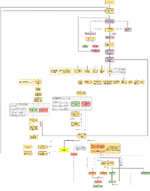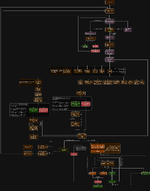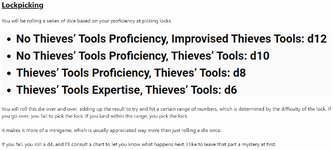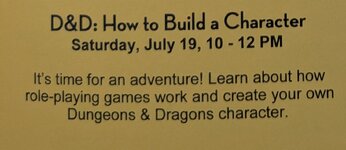VashTheStampede
Self-Care
So...you want to be a hero? But you have NO IDEA how to play D&D? Hopefully this helps.
What is Dungeons & Dragons?
At its core, D&D is a game about telling stories. The Dungeon Master (DM) is the primary storyteller, and the player is a protagonist in the tale, also helping to tell the story through the decisions they make. Its a little bit childhood make-believe, and a little bit improv. The big difference is that there is structure involved, typically in the form of rolling dice. You will roll dice to determine whether the decisions you make are successful. You may roll to see if your sword does damage to a troll, to see if the town guard buys into your story of why you're carrying around an unconscious body, or to see if you fall to your death while scaling a cliff face. Anything is possible...but maybe not probable.
There is no "winning" or "losing" in D&D, though you may succeed or fail at certain goals. The game has no real ending. Teams of adventurers embark on "campaigns" that may or may not have a definitive ending point depending on the DM. But your characters will grow and evolve over time and may embark on several campaigns during their lifetime. Or they may die relatively quickly (the early levels of D&D are notoriously dangerous as your character is at its weakest).
Okay...so how do I play?
The typical ebb and flow of the game follows a simple philosophy.
1. The DM sets the scene.
The DM explains where you are, what's going on around you, and typically provides a range of options on what they can do next. You're in a tavern. A bar fight is breaking out. In the far corner, a shadowy character is staring at your party. A patron is harassing the bartender. What do you want to do?
2. The players decide what to do.
Often times one member of the party will take the lead for the team and make a call. Other times the DM may ask a specific member of the party what they choose to do. That player may choose one of the paths presented to them. Or (and I'm speaking from experience here) they may ignore the obvious plot-threads and decide to use the chaos of the room to sneak away and find gold to steal. There's always one player looking for gold to steal.
3. The DM presents the consequences of the player actions
The DM will then usually present the player with a "skill check" where they will roll a die and take the value on the die and add it to a stat on their character sheet to determine whether their plan was successful. In this example, the DM would likely ask for a "Stealth check" and the player would roll a d20, and add the resulting roll to their "Stealth modifier". They report this result to the DM, who will then tell them how they were (or weren't) able to avoid the attention of the shadowy character as they attempted to sneak upstairs to search for loot. If successful, the DM may then proceed back to Step 1, and set the scene of the upstairs area of the Tavern.
What is Dungeons & Dragons?
At its core, D&D is a game about telling stories. The Dungeon Master (DM) is the primary storyteller, and the player is a protagonist in the tale, also helping to tell the story through the decisions they make. Its a little bit childhood make-believe, and a little bit improv. The big difference is that there is structure involved, typically in the form of rolling dice. You will roll dice to determine whether the decisions you make are successful. You may roll to see if your sword does damage to a troll, to see if the town guard buys into your story of why you're carrying around an unconscious body, or to see if you fall to your death while scaling a cliff face. Anything is possible...but maybe not probable.
There is no "winning" or "losing" in D&D, though you may succeed or fail at certain goals. The game has no real ending. Teams of adventurers embark on "campaigns" that may or may not have a definitive ending point depending on the DM. But your characters will grow and evolve over time and may embark on several campaigns during their lifetime. Or they may die relatively quickly (the early levels of D&D are notoriously dangerous as your character is at its weakest).
Okay...so how do I play?
The typical ebb and flow of the game follows a simple philosophy.
1. The DM sets the scene.
The DM explains where you are, what's going on around you, and typically provides a range of options on what they can do next. You're in a tavern. A bar fight is breaking out. In the far corner, a shadowy character is staring at your party. A patron is harassing the bartender. What do you want to do?
2. The players decide what to do.
Often times one member of the party will take the lead for the team and make a call. Other times the DM may ask a specific member of the party what they choose to do. That player may choose one of the paths presented to them. Or (and I'm speaking from experience here) they may ignore the obvious plot-threads and decide to use the chaos of the room to sneak away and find gold to steal. There's always one player looking for gold to steal.
3. The DM presents the consequences of the player actions
The DM will then usually present the player with a "skill check" where they will roll a die and take the value on the die and add it to a stat on their character sheet to determine whether their plan was successful. In this example, the DM would likely ask for a "Stealth check" and the player would roll a d20, and add the resulting roll to their "Stealth modifier". They report this result to the DM, who will then tell them how they were (or weren't) able to avoid the attention of the shadowy character as they attempted to sneak upstairs to search for loot. If successful, the DM may then proceed back to Step 1, and set the scene of the upstairs area of the Tavern.
Last edited:
VashTheStampede
Self-Care
What's a d20?
Most actions in D&D are determined by rolling various dice. Dice are referred to by the number of sides they have. The dice that most people grow up with are called d6. The dice that are used by D&D players are d4, d6, d8, d10, d12, and the beloved d20.
Every being in D&D (player, monster, NPC) is defined by six Ability Scores. These are Strength (STR), Dexterity (DEX), Constitution (CON), Intelligence (INT), Wisdom (WIS), and Charisma (CHA). Your score in these fields will determine what you add or subtract to a die roll to figure out if you are successful on a roll (aka "check").
Example: Gorgug wants to open a door. The door is locked. Gorgug does not have any thieves tools to attempt a lockpick. Gorgug decides to smash the door down. He asks the DM if he can just ram through the door.
The DM tells Gorgug "Make a STR check". The DM will attribute a "Difficulty Class (DC)" to this action. He does not tell Gorgug what the DC is.
Gorgug rolls a d20. He rolls an 11. Gorgug has a STR rating of 14, therefore he has a Strength modifier of +2. His STR Check result is 13, and that's what he tells the DM he rolled.
The DM knows that he set the DC of breaking down the door at 10, so he confirms to Gorgug that he succeeds.
Advantage and Disadvantage
Sometimes, due to special circumstances, you may have "advantage" or "disadvantage" on an attack or ability check.
Perhaps a party member cast a spell on you to strengthen your next attack. You could have "advantage". In this case, you roll TWO d20s, and the higher roll is your result.
Disadvantage is obviously the opposite. You roll two d20s and take the lower roll as your result.
Most actions in D&D are determined by rolling various dice. Dice are referred to by the number of sides they have. The dice that most people grow up with are called d6. The dice that are used by D&D players are d4, d6, d8, d10, d12, and the beloved d20.
Every being in D&D (player, monster, NPC) is defined by six Ability Scores. These are Strength (STR), Dexterity (DEX), Constitution (CON), Intelligence (INT), Wisdom (WIS), and Charisma (CHA). Your score in these fields will determine what you add or subtract to a die roll to figure out if you are successful on a roll (aka "check").
Example: Gorgug wants to open a door. The door is locked. Gorgug does not have any thieves tools to attempt a lockpick. Gorgug decides to smash the door down. He asks the DM if he can just ram through the door.
The DM tells Gorgug "Make a STR check". The DM will attribute a "Difficulty Class (DC)" to this action. He does not tell Gorgug what the DC is.
Gorgug rolls a d20. He rolls an 11. Gorgug has a STR rating of 14, therefore he has a Strength modifier of +2. His STR Check result is 13, and that's what he tells the DM he rolled.
The DM knows that he set the DC of breaking down the door at 10, so he confirms to Gorgug that he succeeds.
Advantage and Disadvantage
Sometimes, due to special circumstances, you may have "advantage" or "disadvantage" on an attack or ability check.
Perhaps a party member cast a spell on you to strengthen your next attack. You could have "advantage". In this case, you roll TWO d20s, and the higher roll is your result.
Disadvantage is obviously the opposite. You roll two d20s and take the lower roll as your result.
Last edited:
VashTheStampede
Self-Care
Character Creation
1. Select a Race
(One day they'll finally switch to a better term for it)
Each character belongs to one of the intelligent humanoid species that makes up the D&D world. Some of these races also have subraces, further differentiating certain races. Your race is not just for flavor purposes, as you will get stats increases/decreases and even special racial abilities depending on which you choose.
A quick overview of some of the races available:
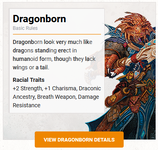
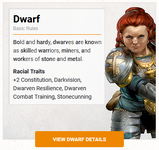
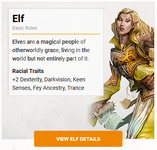

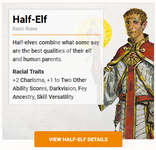

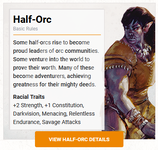
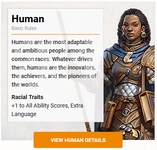
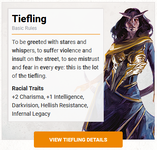
1. Select a Race
(One day they'll finally switch to a better term for it)
Each character belongs to one of the intelligent humanoid species that makes up the D&D world. Some of these races also have subraces, further differentiating certain races. Your race is not just for flavor purposes, as you will get stats increases/decreases and even special racial abilities depending on which you choose.
A quick overview of some of the races available:









Last edited:
VashTheStampede
Self-Care
2. Select a Class
This is best summarized as your character's calling. It shapes the way you think about the world and how you interact with it. A fighter, for instance, may view the world in terms of strategy and maneuvering, and see themselves as just a pawn in a much larger game. A cleric, however, may see themselves as a willing servant in the greater plan of their chosen deity.
This is best summarized as your character's calling. It shapes the way you think about the world and how you interact with it. A fighter, for instance, may view the world in terms of strategy and maneuvering, and see themselves as just a pawn in a much larger game. A cleric, however, may see themselves as a willing servant in the greater plan of their chosen deity.
| Class | Description |
|---|---|
| Artificer | A master of invention, they use ingenuity and magic to unlock extraordinary capabilities in objects |
| Barbarian | A fierce warrior who can enter a battle rage |
| Bard | An inspiring magician whose power echoes the music of creation |
| Blood Hunter | A warrior willing to suffer to achieve victory |
| Cleric | A priestly champion who wields divine magic in service of a higher power |
| Druid | A priest of the Old Faith, wielding the powers of nature and adopting animal forms |
| Fighter | A master of martial combat, skilled with a variety of weapons and armor |
| Monk | A master of martial arts, harnessing the power of the body in pursuit of physical and spiritual perfection |
| Paladin | A holy warrior bound to a sacred oath |
| Ranger | A warrior who combats threats on the edges of civilization |
| Rogue | A scoundrel who uses stealth and trickery to overcome obstacles and enemies |
| Sorcerer | A spellcaster who draws on inherent magic from a gift or bloodline |
| Warlock | A wielder of magic that is derived from a bargain with an extraplanar entity |
| Wizard | A scholarly magic-user capable of manipulating the structures of reality |
Last edited:
VashTheStampede
Self-Care
3. Choose a Background (and Personality)
Every story has a beginning. Your background is where you came from, why you became an adventurer, and what your place is in the world at the onset of your adventures. Your fighter may have been a valiant knight, or perhaps a grizzled mercenary. Your rogue may have been a member of a thieves guild, or maybe he was a court jester.
Your background is more than just flavor. It may speak to your motivation, but it also shapes what you're good at, what languages you understand, and what equipment you begin your adventures with.
EXAMPLE:
Background: Entertainer
Skill Proficiencies: Acrobatics, Performance
Tool Proficiencies: Disguise kit, one type of musical instrument
Equipment: A musical instrument (of your choice), the favor of an admirer (love letter, lock of hair, or trinket), a costume, and a pouch containing 15 gp.
Entertainer Routine: Poet
Feature: By Popular Demand
(In a town or city, you can always find a place to perform, usually in an inn or tavern, but possibly with a circus, at a theatre, or even in a noble's court. At such a place, you receive free lodging and food of a modest or comfortable standard (depending on the quality of the establishment), as long as you perform each night. In addition, your performance makes you something of a local figure. When strangers recognize you in a town where you have performed, they typically take a liking to you.
Cult of Personality
The other part of your character's background that you should spend a little time with is the different aspects of their personality. The commonly accepted method is to choose two Traits, an Ideal, a Bond, and a Flaw. The Player's Handbook provides examples that correspond to each Background.
EXAMPLE:
Trait: I know a story relevant to almost every situation.
Trait: Nobody stays angry at me or around me for long, since I can defuse any amount of tension.
Ideal: Tradition: The stories, legends, and songs of the past must never be forgotten, for they teach us who we are.
Bond: Someone stole my precious instrument, and someday I'll get it back.
Flaw: I'm a sucker for a pretty face.
Every story has a beginning. Your background is where you came from, why you became an adventurer, and what your place is in the world at the onset of your adventures. Your fighter may have been a valiant knight, or perhaps a grizzled mercenary. Your rogue may have been a member of a thieves guild, or maybe he was a court jester.
Your background is more than just flavor. It may speak to your motivation, but it also shapes what you're good at, what languages you understand, and what equipment you begin your adventures with.
EXAMPLE:
Background: Entertainer
Skill Proficiencies: Acrobatics, Performance
Tool Proficiencies: Disguise kit, one type of musical instrument
Equipment: A musical instrument (of your choice), the favor of an admirer (love letter, lock of hair, or trinket), a costume, and a pouch containing 15 gp.
Entertainer Routine: Poet
Feature: By Popular Demand
(In a town or city, you can always find a place to perform, usually in an inn or tavern, but possibly with a circus, at a theatre, or even in a noble's court. At such a place, you receive free lodging and food of a modest or comfortable standard (depending on the quality of the establishment), as long as you perform each night. In addition, your performance makes you something of a local figure. When strangers recognize you in a town where you have performed, they typically take a liking to you.
Cult of Personality
The other part of your character's background that you should spend a little time with is the different aspects of their personality. The commonly accepted method is to choose two Traits, an Ideal, a Bond, and a Flaw. The Player's Handbook provides examples that correspond to each Background.
EXAMPLE:
Trait: I know a story relevant to almost every situation.
Trait: Nobody stays angry at me or around me for long, since I can defuse any amount of tension.
Ideal: Tradition: The stories, legends, and songs of the past must never be forgotten, for they teach us who we are.
Bond: Someone stole my precious instrument, and someday I'll get it back.
Flaw: I'm a sucker for a pretty face.
Last edited:
VashTheStampede
Self-Care
I Want To Kill Things (Vash's Guide to Combat)
Combat is typically a martial clash between your party and a group of hostile entities, be they monsters or NPCs. During a round of combat, every participant gets one turn, and represents roughly 6 seconds of in-game action (but from personal experience can take practically an hour of real life time. Please learn your abilities.)
Order of Events
Surprise Round: Let's say your party sneaks up on a camp of goblins. Or perhaps while you were resting for the night, you're surrounded by bandits. Either of these events could lead to combat beginning with a Surprise Round. The DM decides if a group is surprised at the start of combat. If neither side is attempting to be stealthy, then both sides are automatically aware of each other and combat begins as normal. Otherwise, the DM will compare the Stealth checks of anyone hiding against the Passive Perception scores of each being on the other side. Any character who has a Passive Perception lower than the lowest Stealth check is taken by surprise to start combat. This means they cannot move or otherwise take an action (or reaction) in the first turn of combat.
Initiative: This is the turn order. At the onset of combat, everyone will "Roll for Initiative", which is basically a DEX check. The DM will make a roll for each unique type of enemy being, so each member of that group will act at the same time. The DM then ranks the combatants on both sides from highest initiative roll to the lowest. This is the order in which everyone will take their turn and remains the same through every round of combat. In the case of a tie amongst the party, the players decide who goes before whom. The DM decides the order in the case of a tie between enemies or enemies/party members.
A turn: On your turn, you can move a distance up to your speed and take one action, in whichever order you choose. You may also be able to perform a bonus action thanks to class features, spells, or other abilities...but you can only take ONE bonus action per turn. You do not HAVE to move or take an action on your turn if you so wish. If you cannot decide what to do, perhaps consider using a Dodge or Ready action, which will be explained later in this post. Outside of the MOVE/ACTION combination, you can add certain minor flourishes that don't require either of these options. You can communicate to your team through brief comment or gestures (keep in mind that an ENTIRE ROUND of combat takes 6 seconds, so no monologs). You can interact with one object or environmental feature during your movement or action (open a door, draw your weapon).
Reactions: Some situations allow you to take a reaction, which is an instant response to some sort of triggering event. These could take place on your turn or another being's turn, the most common of which is the opportunity attack, which will be described later in this post. When you take a reaction, you cannot take another until the next round of combat begins.
I Like the Way you Move
On your turn, you can move a distance up to your speed. You can break this up with your action. If your speed is 25 feet, you can move 10 feet to get in range of an enemy to attack, and then after your attack action you could still move the remaining 15 feet.
Difficult Terrain: Sometimes combat may take place in places where your footing isn't always sound. Things like rubble, snow, fighting on staircases, and even entering the space of another creature (hostile or not) would be examples of difficult terrain. Each foot of movement in difficult terrain costs 2 feet of speed.
Prone: Sometimes you fall down. This is called being prone. When prone you have disadvantage on attack rolls, and attacks against you from within 5 feet of distance are at advantage. Attacks against you from MORE than 5 feet away have disadvantage. You can drop prone without spending any movement, but it takes half of your speed's worth of movement to stand back up. While prone, the only movement you can make is to either crawl or magically teleport. Crawling costs 2 feet of speed for each foot moved...but in difficult terrain would cost 3.
Moving around others/creature size: You can move through the space of a non-hostile creature. If a creature is hostile, you can move through its space if you are at least two sizes smaller than the creature. Keep in mind that space taken up by another creature is difficult terrain. A typical player (though there are exceptions) is Medium sized, and thus take up a 5x5 foot space. That doesn't mean you're 5 feet wide yourself, but the area you control is that large. Small creatures also take up a 5x5 space. Large creatures take up a 10x10 space. Huge creatures, 15x15...and Gargantuan creatures take up AT LEAST a 20x20 foot space.
ACTION(s)
Attack: See next bold section
Cast a Spell: Each spell has a casting time, which tells you whether it takes an action, reaction, several minutes, or even HOURS to cast the spell. So, casting a spell isn't TECHNICALLY an action...but MOST spells have a casting time of 1 action, so if you're a spellcaster, odds are this is how you're going to use your action a lot of the time.
Dash: This gives you extra movement on your turn. You basically forgo any other action to double your movement speed for your turn. Note that any augments to your speed also affect your dash. If you have a normal speed of 30 ft, but its reduced to 15 ft by a spell or effect, then your Dash would only allow you to move 30 ft instead of 60.
Disengage: If you take this action, your next movement does not provoke an opportunity attack.
Dodge: You focus entirely on avoiding attacks. Until the start of your next turn, all attacks against you are at Disadvantage (if you can see the attacker). Any DEX saving throws you make are at Advantage. (You lose this if you are incapacitated or your speed is lowered to 0).
Help: You lend aid to another being. The being that you "help" gains advantage on the next check it makes to perform the task you are helping them with, as long as the check occurs before your next turn. Alternatively, you can assist a friendly being in attacking an enemy within 5 feet of you. You do something (distract, fake an attack, its up to you) that makes your ally's attack more likely to succeed. This gives them advantage on their next attack roll (assuming its before your next turn).
Hide: You make a Stealth check to try and hide. If hidden, enemies have Disadvantage when trying to hit you and you have Advantage when trying to hit an enemy that cannot see you. When you make an attack, you give away your location and are no longer hidden.
Ready: The most misunderstood action. You do not make an action on your turn, instead you get ready to react to something. First you choose what you are reacting to. Then you choose what your reaction would be. Possible examples could be "when that goblin steps next to me, I move away" or "if that cultist steps on the trapdoor, I pull the lever to open it". If you ready a spell, you cast it as normal but hold its energy, which you release with your reaction when the trigger occurs. To ready a spell, it must have a casting time of 1 action and you must maintain concentration until the trigger occurs.
Search: Dedicate your action to looking for something. Typically the DM will ask for a Perception or an Investigation check.
Use an Object: You interact with an object. Obviously.
ATTACK!
Attacking follows a basic 3 step process.
1. Choose a target - Self explanatory
2. Determine modifiers - The DM determines whether the target has cover and whether there is advantage or disadvantage. Also certain spells or abilities can apply penalties or bonuses to your roll.
3. Resolve the attack - Make an attack roll. If you hit, you roll for damage (unless the attack specifies otherwise).
Making an Attack Roll
You roll a d20, and add whatever modifiers are appropriate. If the total of the roll and the modifiers meets or exceeds the target's Armor Class (AC), then it is a hit. Your AC is on your character sheet. Enemy AC is listed in their stat block, and is typically known only to the DM at the start of a battle. Rolling a 20 on your die (also called a natural 20, or nat 20) is an automatic hit, regardless of modifiers or AC. Rolling a nat 1 is an automatic miss.
Attack Roll Modifiers
If you're making a melee attack, you will usually add your STR modifier. A ranged attack will typically use your DEX modifier. Finesse melee weapons and thrown ranged weapons go against these rules. If you are proficient in the weapon you are using, you also add a proficiency bonus.
Ranged Attacks
All ranged attacks have a listed range that the enemy must be within. Some of these attacks, such as ones made by a shortbow or longbow, have two ranges listed. The smaller number is the normal range. The larger number is the long range. Any attacks on targets outside of normal range have disadvantage, and you cannot target any enemy outside of the long range. If you make a ranged attack on an enemy in melee range (be it by weapon or spell), you have disadvantage.
Opportunity Attacks
In combat, everyone is always looking for a chance to take a swipe at an enemy who is running away or passing by too closely. This is an opportunity attack. If a hostile creature tries to move out of melee range of you, you can use your reaction to make a melee attack against them. Keep in mind that enemies can do the same to you.
Grappling and Shoving
You can grab onto an enemy by using your Attack action to Grapple them (as long as they are no more than 1 size larger than you, and they must be in melee range). You make an Athletics check, opposed by the enemy's Athletics or Acrobatics check (the target chooses which to use). If you succeed, you can move or drag the enemy around but you move at half-speed (unless they are 2 or more sizes smaller than you). A grappled being can use its action to escape by attempting an Athletics or Acrobatics check, opposed by the grappler's Athletics check.
You can attempt to shove an enemy and either knock it prone or push it away from you. Instead of an attack roll, you make an Athletics check, opposed by the enemy's Athletics or Acrobatics check. If you win, you either knock them down or push them 5 feet away from you.
Cover
You can use walls, trees, and other obstacles to provide cover to become more difficult to harm. There are 3 degrees of cover. If you're considered to be in half-cover (an obstacle blocking at least half of your body), you get a +2 bonus to your AC and DEX saving throws. Three-quarters cover grants a +5 bonus to AC and DEX saves. Total cover means you cannot be targeted directly by spells or attacks, though you could still be hit by area-of-effect abilities.
What's your damage? (Damage and Healing)
Hit Points (HP) represent a combination of your physical and mental condition. Whenever you take damage by any means, that damage is taken away from your HP. Losing HP does not affect your disposition or capabilities until you drop to 0 HP.
Damage Rolls
Every weapon, spell, or ability that does damage will specify the damage it deals. You roll the damage die (or dice) specified, add any applicable modifiers, then apply that damage to your target. When attacking with a weapon, add your ability modifier (the same modifier you used for the attack roll) to the damage. When attacking with a spell, the spell will tell you which dice to roll for damage and whether to use any modifiers. If a spell or other ability targets multiple enemies at one time, you roll the damage once for each of them.
Critical Hits
When you score a critical hit (usually by rolling a 20, but some abilities expand the range of a critical), you get to roll extra dice for your damage. Roll all of the specified damage dice TWICE, and add them together. Then add your relevant modifiers. For example, if you score a critical hit with a dagger, instead of rolling 1d4, you will roll 2d4, then add your relevant modifier. If the attack involves extra damage dice (like with a Rogue's Sneak Attack), you double the number of those dice as well.
Types of Damage
Different attacks and spells do different types of damage. The different types have no specific rules associated with them (cold damage doesn't slow anyone, for example) but other rules such as damage resistance rely on these types. The different types of damage include:
ACID: Corrosive sprays and dissolving enzymes
BLUDGEONING: Blunt force trauma
COLD: Frigid chill
FIRE: Burninate
FORCE: Pure magical energy channeled into physical form
LIGHTNING: Shocking
NECROTIC: Withers matter and possibly the soul
PIERCING: Puncturing and impaling
POISON: Venomous stings and toxic gas
PSYCHIC: Assault on the mind
RADIANT: Sears like fire and overloads the spirit with holy power
SLASHING: Swords, axes, and the claws of monsters
THUNDER: Concussive bursts of sound
Damage Resistance and Vulnerability
Some beings are more difficult or much easier to wound with specific types of damage. If a being has resistance to a damage type, they take half of the allotted damage from those attacks. If a being has vulnerability, those attacks are super effective! They take double damage. Resistance and vulnerability are applied after all other modifiers to damage. If a creature has resistance to piercing damage, and then takes an attack that deals 25 piercing damage, but is within a magical field that reduces all damage by 5, then the damage is first reduced to 20 by the field, and then halved to 10 by resistance. Multiple types of resistance or vulnerability do not stack. If a creature is resistance to both fire damage and all types of non-magical damage, non-magical fire damage is reduced by half, not 3/4s.
Healing
Unless it results in death, damage is not permanent. Even death isn't necessarily permanent. Rest can restore HP, as can magical means such as a Cure Wounds spell or a Potion of Healing can remove damage in the blink of an eye. When you receive healing of any kind, HP regained is added to your current HP total, but cannot exceed your maximum HP. A being that has died cannot regain HP until magic such as Revivify has been used to bring them back to life.
So...you're at 0 HP
This means you either fell unconscious... or you died outright.
Instant Death
If you take a large amount of damage at once, this can kill you instantly. Any time a source of damage reduces you to 0 HP and there's more damage remaining...you die if the remaining damage equals or surpasses your HP maximum.
Falling Unconscious
If damage reduces you to 0 HP but fails to kill you, you fall unconscious. This state ends if you regain any HP.
Death Saving Throws
When your turn starts with you unconscious, you must make a special kind of saving throw, called a death saving throw, to determine whether you are creeping closer to death, or if you are hanging onto life. This roll is not tied to any ability score. You are in the hands of fate now, aided only by spells and features that improve your chances at success.
Roll a d20. If you roll a 10 or higher, you succeed. Otherwise, you fail. On your THIRD success, you become stable. You no longer have to make death saving throws, even though you remain at 0 HP, but you are still unconscious. If you take any additional damage, you lose your stability and must start making death saving throws once more. On your THIRD failure, you die. Successes and failures do not need to be consecutive.
If you roll a nat 20 on a death saving throw, it counts as two successes. If you roll a nat 1, it counts as two failures.
If you take any damage when you are at 0 HP and you are not stable, you suffer a death saving throw failure. If the damage is from a critical hit, you suffer two failures. If the damage exceeds your maximum HP, you die.
Monsters and Death
DMs will typically have a monster die the moment it reaches 0 HP. However, more dangerous villains or NPCs may be privy to the same death saving throw system as players.
However, if an attacker wants to simply incapacitate a foe, if the attack that drops the enemy to 0 HP was a melee attack, they can choose instead to knock the enemy unconscious for story reasons (possibly interrogation? Or a bounty on a villain specifies they be brought back alive?)
Combat is typically a martial clash between your party and a group of hostile entities, be they monsters or NPCs. During a round of combat, every participant gets one turn, and represents roughly 6 seconds of in-game action (but from personal experience can take practically an hour of real life time. Please learn your abilities.)
Order of Events
Surprise Round: Let's say your party sneaks up on a camp of goblins. Or perhaps while you were resting for the night, you're surrounded by bandits. Either of these events could lead to combat beginning with a Surprise Round. The DM decides if a group is surprised at the start of combat. If neither side is attempting to be stealthy, then both sides are automatically aware of each other and combat begins as normal. Otherwise, the DM will compare the Stealth checks of anyone hiding against the Passive Perception scores of each being on the other side. Any character who has a Passive Perception lower than the lowest Stealth check is taken by surprise to start combat. This means they cannot move or otherwise take an action (or reaction) in the first turn of combat.
Initiative: This is the turn order. At the onset of combat, everyone will "Roll for Initiative", which is basically a DEX check. The DM will make a roll for each unique type of enemy being, so each member of that group will act at the same time. The DM then ranks the combatants on both sides from highest initiative roll to the lowest. This is the order in which everyone will take their turn and remains the same through every round of combat. In the case of a tie amongst the party, the players decide who goes before whom. The DM decides the order in the case of a tie between enemies or enemies/party members.
A turn: On your turn, you can move a distance up to your speed and take one action, in whichever order you choose. You may also be able to perform a bonus action thanks to class features, spells, or other abilities...but you can only take ONE bonus action per turn. You do not HAVE to move or take an action on your turn if you so wish. If you cannot decide what to do, perhaps consider using a Dodge or Ready action, which will be explained later in this post. Outside of the MOVE/ACTION combination, you can add certain minor flourishes that don't require either of these options. You can communicate to your team through brief comment or gestures (keep in mind that an ENTIRE ROUND of combat takes 6 seconds, so no monologs). You can interact with one object or environmental feature during your movement or action (open a door, draw your weapon).
Reactions: Some situations allow you to take a reaction, which is an instant response to some sort of triggering event. These could take place on your turn or another being's turn, the most common of which is the opportunity attack, which will be described later in this post. When you take a reaction, you cannot take another until the next round of combat begins.
I Like the Way you Move
On your turn, you can move a distance up to your speed. You can break this up with your action. If your speed is 25 feet, you can move 10 feet to get in range of an enemy to attack, and then after your attack action you could still move the remaining 15 feet.
Difficult Terrain: Sometimes combat may take place in places where your footing isn't always sound. Things like rubble, snow, fighting on staircases, and even entering the space of another creature (hostile or not) would be examples of difficult terrain. Each foot of movement in difficult terrain costs 2 feet of speed.
Prone: Sometimes you fall down. This is called being prone. When prone you have disadvantage on attack rolls, and attacks against you from within 5 feet of distance are at advantage. Attacks against you from MORE than 5 feet away have disadvantage. You can drop prone without spending any movement, but it takes half of your speed's worth of movement to stand back up. While prone, the only movement you can make is to either crawl or magically teleport. Crawling costs 2 feet of speed for each foot moved...but in difficult terrain would cost 3.
Moving around others/creature size: You can move through the space of a non-hostile creature. If a creature is hostile, you can move through its space if you are at least two sizes smaller than the creature. Keep in mind that space taken up by another creature is difficult terrain. A typical player (though there are exceptions) is Medium sized, and thus take up a 5x5 foot space. That doesn't mean you're 5 feet wide yourself, but the area you control is that large. Small creatures also take up a 5x5 space. Large creatures take up a 10x10 space. Huge creatures, 15x15...and Gargantuan creatures take up AT LEAST a 20x20 foot space.
ACTION(s)
Attack: See next bold section
Cast a Spell: Each spell has a casting time, which tells you whether it takes an action, reaction, several minutes, or even HOURS to cast the spell. So, casting a spell isn't TECHNICALLY an action...but MOST spells have a casting time of 1 action, so if you're a spellcaster, odds are this is how you're going to use your action a lot of the time.
Dash: This gives you extra movement on your turn. You basically forgo any other action to double your movement speed for your turn. Note that any augments to your speed also affect your dash. If you have a normal speed of 30 ft, but its reduced to 15 ft by a spell or effect, then your Dash would only allow you to move 30 ft instead of 60.
Disengage: If you take this action, your next movement does not provoke an opportunity attack.
Dodge: You focus entirely on avoiding attacks. Until the start of your next turn, all attacks against you are at Disadvantage (if you can see the attacker). Any DEX saving throws you make are at Advantage. (You lose this if you are incapacitated or your speed is lowered to 0).
Help: You lend aid to another being. The being that you "help" gains advantage on the next check it makes to perform the task you are helping them with, as long as the check occurs before your next turn. Alternatively, you can assist a friendly being in attacking an enemy within 5 feet of you. You do something (distract, fake an attack, its up to you) that makes your ally's attack more likely to succeed. This gives them advantage on their next attack roll (assuming its before your next turn).
Hide: You make a Stealth check to try and hide. If hidden, enemies have Disadvantage when trying to hit you and you have Advantage when trying to hit an enemy that cannot see you. When you make an attack, you give away your location and are no longer hidden.
Ready: The most misunderstood action. You do not make an action on your turn, instead you get ready to react to something. First you choose what you are reacting to. Then you choose what your reaction would be. Possible examples could be "when that goblin steps next to me, I move away" or "if that cultist steps on the trapdoor, I pull the lever to open it". If you ready a spell, you cast it as normal but hold its energy, which you release with your reaction when the trigger occurs. To ready a spell, it must have a casting time of 1 action and you must maintain concentration until the trigger occurs.
Search: Dedicate your action to looking for something. Typically the DM will ask for a Perception or an Investigation check.
Use an Object: You interact with an object. Obviously.
ATTACK!
Attacking follows a basic 3 step process.
1. Choose a target - Self explanatory
2. Determine modifiers - The DM determines whether the target has cover and whether there is advantage or disadvantage. Also certain spells or abilities can apply penalties or bonuses to your roll.
3. Resolve the attack - Make an attack roll. If you hit, you roll for damage (unless the attack specifies otherwise).
Making an Attack Roll
You roll a d20, and add whatever modifiers are appropriate. If the total of the roll and the modifiers meets or exceeds the target's Armor Class (AC), then it is a hit. Your AC is on your character sheet. Enemy AC is listed in their stat block, and is typically known only to the DM at the start of a battle. Rolling a 20 on your die (also called a natural 20, or nat 20) is an automatic hit, regardless of modifiers or AC. Rolling a nat 1 is an automatic miss.
Attack Roll Modifiers
If you're making a melee attack, you will usually add your STR modifier. A ranged attack will typically use your DEX modifier. Finesse melee weapons and thrown ranged weapons go against these rules. If you are proficient in the weapon you are using, you also add a proficiency bonus.
Ranged Attacks
All ranged attacks have a listed range that the enemy must be within. Some of these attacks, such as ones made by a shortbow or longbow, have two ranges listed. The smaller number is the normal range. The larger number is the long range. Any attacks on targets outside of normal range have disadvantage, and you cannot target any enemy outside of the long range. If you make a ranged attack on an enemy in melee range (be it by weapon or spell), you have disadvantage.
Opportunity Attacks
In combat, everyone is always looking for a chance to take a swipe at an enemy who is running away or passing by too closely. This is an opportunity attack. If a hostile creature tries to move out of melee range of you, you can use your reaction to make a melee attack against them. Keep in mind that enemies can do the same to you.
Grappling and Shoving
You can grab onto an enemy by using your Attack action to Grapple them (as long as they are no more than 1 size larger than you, and they must be in melee range). You make an Athletics check, opposed by the enemy's Athletics or Acrobatics check (the target chooses which to use). If you succeed, you can move or drag the enemy around but you move at half-speed (unless they are 2 or more sizes smaller than you). A grappled being can use its action to escape by attempting an Athletics or Acrobatics check, opposed by the grappler's Athletics check.
You can attempt to shove an enemy and either knock it prone or push it away from you. Instead of an attack roll, you make an Athletics check, opposed by the enemy's Athletics or Acrobatics check. If you win, you either knock them down or push them 5 feet away from you.
Cover
You can use walls, trees, and other obstacles to provide cover to become more difficult to harm. There are 3 degrees of cover. If you're considered to be in half-cover (an obstacle blocking at least half of your body), you get a +2 bonus to your AC and DEX saving throws. Three-quarters cover grants a +5 bonus to AC and DEX saves. Total cover means you cannot be targeted directly by spells or attacks, though you could still be hit by area-of-effect abilities.
What's your damage? (Damage and Healing)
Hit Points (HP) represent a combination of your physical and mental condition. Whenever you take damage by any means, that damage is taken away from your HP. Losing HP does not affect your disposition or capabilities until you drop to 0 HP.
Damage Rolls
Every weapon, spell, or ability that does damage will specify the damage it deals. You roll the damage die (or dice) specified, add any applicable modifiers, then apply that damage to your target. When attacking with a weapon, add your ability modifier (the same modifier you used for the attack roll) to the damage. When attacking with a spell, the spell will tell you which dice to roll for damage and whether to use any modifiers. If a spell or other ability targets multiple enemies at one time, you roll the damage once for each of them.
Critical Hits
When you score a critical hit (usually by rolling a 20, but some abilities expand the range of a critical), you get to roll extra dice for your damage. Roll all of the specified damage dice TWICE, and add them together. Then add your relevant modifiers. For example, if you score a critical hit with a dagger, instead of rolling 1d4, you will roll 2d4, then add your relevant modifier. If the attack involves extra damage dice (like with a Rogue's Sneak Attack), you double the number of those dice as well.
Types of Damage
Different attacks and spells do different types of damage. The different types have no specific rules associated with them (cold damage doesn't slow anyone, for example) but other rules such as damage resistance rely on these types. The different types of damage include:
ACID: Corrosive sprays and dissolving enzymes
BLUDGEONING: Blunt force trauma
COLD: Frigid chill
FIRE: Burninate
FORCE: Pure magical energy channeled into physical form
LIGHTNING: Shocking
NECROTIC: Withers matter and possibly the soul
PIERCING: Puncturing and impaling
POISON: Venomous stings and toxic gas
PSYCHIC: Assault on the mind
RADIANT: Sears like fire and overloads the spirit with holy power
SLASHING: Swords, axes, and the claws of monsters
THUNDER: Concussive bursts of sound
Damage Resistance and Vulnerability
Some beings are more difficult or much easier to wound with specific types of damage. If a being has resistance to a damage type, they take half of the allotted damage from those attacks. If a being has vulnerability, those attacks are super effective! They take double damage. Resistance and vulnerability are applied after all other modifiers to damage. If a creature has resistance to piercing damage, and then takes an attack that deals 25 piercing damage, but is within a magical field that reduces all damage by 5, then the damage is first reduced to 20 by the field, and then halved to 10 by resistance. Multiple types of resistance or vulnerability do not stack. If a creature is resistance to both fire damage and all types of non-magical damage, non-magical fire damage is reduced by half, not 3/4s.
Healing
Unless it results in death, damage is not permanent. Even death isn't necessarily permanent. Rest can restore HP, as can magical means such as a Cure Wounds spell or a Potion of Healing can remove damage in the blink of an eye. When you receive healing of any kind, HP regained is added to your current HP total, but cannot exceed your maximum HP. A being that has died cannot regain HP until magic such as Revivify has been used to bring them back to life.
So...you're at 0 HP
This means you either fell unconscious... or you died outright.
Instant Death
If you take a large amount of damage at once, this can kill you instantly. Any time a source of damage reduces you to 0 HP and there's more damage remaining...you die if the remaining damage equals or surpasses your HP maximum.
Falling Unconscious
If damage reduces you to 0 HP but fails to kill you, you fall unconscious. This state ends if you regain any HP.
Death Saving Throws
When your turn starts with you unconscious, you must make a special kind of saving throw, called a death saving throw, to determine whether you are creeping closer to death, or if you are hanging onto life. This roll is not tied to any ability score. You are in the hands of fate now, aided only by spells and features that improve your chances at success.
Roll a d20. If you roll a 10 or higher, you succeed. Otherwise, you fail. On your THIRD success, you become stable. You no longer have to make death saving throws, even though you remain at 0 HP, but you are still unconscious. If you take any additional damage, you lose your stability and must start making death saving throws once more. On your THIRD failure, you die. Successes and failures do not need to be consecutive.
If you roll a nat 20 on a death saving throw, it counts as two successes. If you roll a nat 1, it counts as two failures.
If you take any damage when you are at 0 HP and you are not stable, you suffer a death saving throw failure. If the damage is from a critical hit, you suffer two failures. If the damage exceeds your maximum HP, you die.
Monsters and Death
DMs will typically have a monster die the moment it reaches 0 HP. However, more dangerous villains or NPCs may be privy to the same death saving throw system as players.
However, if an attacker wants to simply incapacitate a foe, if the attack that drops the enemy to 0 HP was a melee attack, they can choose instead to knock the enemy unconscious for story reasons (possibly interrogation? Or a bounty on a villain specifies they be brought back alive?)
Last edited:
Dungeons & Flowcharts
I've made a valiant effort to try to capture the core mechanics of D&D and how encounters, etc. go, in a flowchart form. Because I'm a nerd.


For real though;
If anyone spots glaring errors, please do point them out.
(The "Posts must be made in BOLD GREEN" part may change depending on DM/flavor. But we'll decide on some way to make actions stand out from conversation.)
I've made a valiant effort to try to capture the core mechanics of D&D and how encounters, etc. go, in a flowchart form. Because I'm a nerd.


For real though;
If anyone spots glaring errors, please do point them out.
(The "Posts must be made in BOLD GREEN" part may change depending on DM/flavor. But we'll decide on some way to make actions stand out from conversation.)
GLOSSARY OF 20 USEFUL TERMS
- **Ability Scores**: The six basic attributes of a character, which are Strength, Dexterity, Constitution, Intelligence, Wisdom, and Charisma.
- **AC (Armor Class)**: A measure of how difficult it is to hit a character with a physical attack. A higher AC means the character is harder to hit.
- **Advantage/Disadvantage**: A mechanic where a player rolls two d20s and takes the higher (advantage) or lower (disadvantage) result, usually due to some in-game condition or effect.
- **Alignment**: A character's moral and ethical orientation, with axes of Good vs. Evil and Lawful vs. Chaotic.
- **Campaign**: A series of gaming sessions in D&D that forms a larger storyline.
- **Character Sheet**: A record of all the information about a player's character, including abilities, equipment, experience points, and backstory.
- **Critical Hit (Crit)**: An attack roll that hits an opponent and deals extra damage, usually occurring on a natural roll of 20.
- **D20**: A twenty-sided die, which is the most commonly used die in D&D.
- **DM (Dungeon Master)**: The game organizer and narrator who sets the stage for the adventure and controls its progression.
- **Encounter**: A situation where players face a challenge, which could be a combat scenario, a puzzle, or a social interaction.
- **Experience Points (XP)**: Points awarded for overcoming challenges or completing tasks, which accumulate to allow a character to level up.
- **Hit Points (HP)**: A numerical representation of how much damage a character can take before becoming unconscious or dying.
- **Initiative**: A roll at the start of combat to determine the order in which characters act.
- **Level**: A measure of a character's power and skill, which increases through gaining experience points.
- **NPC (Non-Player Character)**: Characters in the game world controlled by the Dungeon Master.
- **PC (Player Character)**: The characters controlled by the players.
- **Saving Throw**: A roll to resist or reduce the effects of spells, poisons, traps, and other hazards.
- **Spell Save DC**: The difficulty class for saving throws against a character's spells, representing how hard the spells are to resist.
- **Turn**: In combat, a specific segment of time in which a character can perform actions.
- **DC**: stands for "Difficulty Class." It is a numerical value that represents the difficulty of a particular task, action, or saving throw.
Including this here so it's easier for people to find in the future.
Get your nerd flair. Treat yo'self.
View group 7
Get your nerd flair. Treat yo'self.
View group 7
VashTheStampede
Self-Care
Attunement
Some magic items require a creature to form a bond with them before their magical properties can be used. This bond is called attunement, and certain items have a prerequisite for it. If the prerequisite is a class, a creature must be a member of that class to attune to the item. (If the class is a spellcasting class, a monster qualifies if it has spell slots and uses that class's spell list.) If the prerequisite is to be a spellcaster, a creature qualifies if it can cast at least one spell using its traits or features, not using a magic item or the like.
Without becoming attuned to an item that requires attunement, a creature gains only its nonmagical benefits, unless its description states otherwise. For example, a magic shield that requires attunement provides the benefits of a normal shield to a creature not attuned to it, but none of its magical properties.
Attuning to an item requires a creature to spend a short rest focused on only that item while being in physical contact with it (this can't be the same short rest used to learn the item's properties). This focus can take the form of weapon practice (for a weapon), meditation (for a wondrous item), or some other appropriate activity. If the short rest is interrupted, the attunement attempt fails. Otherwise, at the end of the short rest, the creature gains an intuitive understanding of how to activate any magical properties of the item, including any necessary command words.
An item can be attuned to only one creature at a time, and a creature can be attuned to no more than three magic items at a time. Any attempt to attune to a fourth item fails; the creature must end its attunement to an item first. Additionally, a creature can't attune to more than one copy of an item.
A creature's attunement to an item ends if the creature no longer satisfies the prerequisites for attunement, if the item has been more than 100 feet away for at least 24 hours, if the creature dies, or if another creature attunes to the item. A creature can also voluntarily end attunement by spending another short rest focused on the item, unless the item is cursed.
Some magic items require a creature to form a bond with them before their magical properties can be used. This bond is called attunement, and certain items have a prerequisite for it. If the prerequisite is a class, a creature must be a member of that class to attune to the item. (If the class is a spellcasting class, a monster qualifies if it has spell slots and uses that class's spell list.) If the prerequisite is to be a spellcaster, a creature qualifies if it can cast at least one spell using its traits or features, not using a magic item or the like.
Without becoming attuned to an item that requires attunement, a creature gains only its nonmagical benefits, unless its description states otherwise. For example, a magic shield that requires attunement provides the benefits of a normal shield to a creature not attuned to it, but none of its magical properties.
Attuning to an item requires a creature to spend a short rest focused on only that item while being in physical contact with it (this can't be the same short rest used to learn the item's properties). This focus can take the form of weapon practice (for a weapon), meditation (for a wondrous item), or some other appropriate activity. If the short rest is interrupted, the attunement attempt fails. Otherwise, at the end of the short rest, the creature gains an intuitive understanding of how to activate any magical properties of the item, including any necessary command words.
An item can be attuned to only one creature at a time, and a creature can be attuned to no more than three magic items at a time. Any attempt to attune to a fourth item fails; the creature must end its attunement to an item first. Additionally, a creature can't attune to more than one copy of an item.
A creature's attunement to an item ends if the creature no longer satisfies the prerequisites for attunement, if the item has been more than 100 feet away for at least 24 hours, if the creature dies, or if another creature attunes to the item. A creature can also voluntarily end attunement by spending another short rest focused on the item, unless the item is cursed.
VashTheStampede
Self-Care
Stop by and make sure everyone gives their character ice knifeThis felt like an appropriate thread to say my local library has some pretty cool summer programs, including this one:
View attachment 31399


